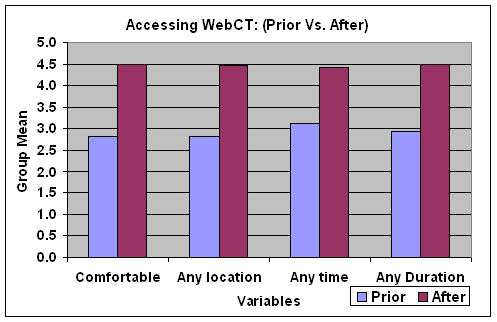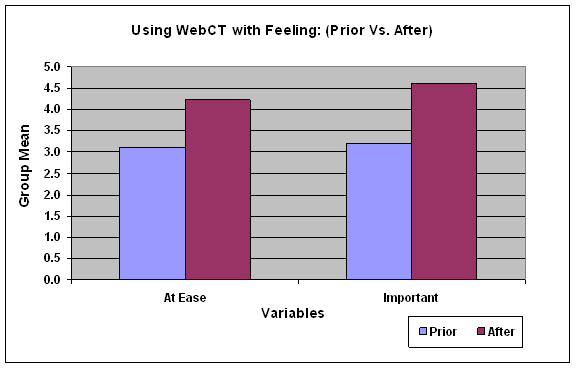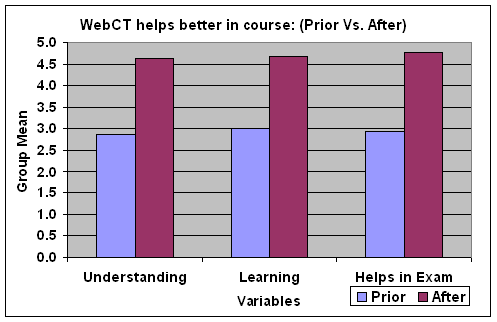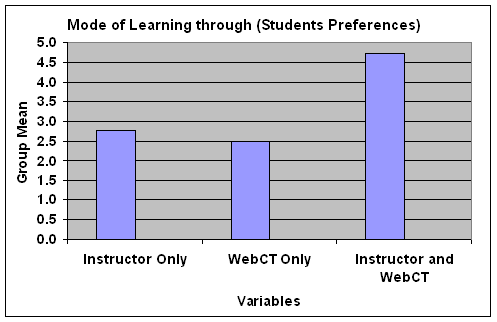Impact of WebCT on learning: An Oman experience
Syed Naqvi
Sultan Qaboos University, Sultanate of Oman
ABSTRACT
The World Wide Web Course Tool (WebCT), Blackboard and Moodle are used for teaching and learning in higher education institutions around the globe. This study investigated the impact of WebCT on students learning taking a course "Introduction to Computers in Business" offered at the College of Commerce and Economics, Sultan Qaboos University in the Sultanate of Oman. The finding showed that though the students have little exposure of WebCT at the beginning of the course but towards the end they have appreciated the importance and the use of WebCT as it is easily accessible from any Internet enabled location at any time. In addition it helps them in better understanding and learning the course material.
Keywords: WebCT; Information Technology; on-line learning; Internet; students
INTRODUCTION
Trends affecting education
One of the most apparent trends affecting education is the advancement of technology. As computers are increasing in speed while decreasing in cost, and high-speed network connections continue to expand (Cetron and Daview, 2003). This advancement in technology transforming higher education (Oblinger et al., 2001), one example being the changes caused by broader use of digital course materials (Chick et al., 2002). By the year 2012, schools and colleges will routinely use "computerized teaching programs and interactive television lectures and seminars, as well as traditional methods" (Emerging technologies and ground-floor investment opportunities: Special Report, 2003). Videoconferencing and other technologies will also help enrich distance media and provide many benefits over the face-to-face instructions.
Online learning is said to be an innovative way of learning suited to meet today's learner's learning requirements, particularly as the industrial economy evolves into a knowledge-based economy (EU-Asia e-learning, 2003).
Hadengue (2004) describes online learning, as an educational concept, which utilizes local area networks (LAN), wide area networks (WAN), or the Internet to communicate and spread digital material in support of learning and students and teachers interaction. Wang and Hwang (2004) argued that the effective learning process could be created by electronically delivered content in support of more learning. The online learning is becoming the way to go if students are encouraged to take more responsibility on their learning goals (Thurab-Nkhosi, 2003) and if education is to be made available to all irrespective of location and status in the society on affordable scale (Lumande et. al 2005).
Dunn (2000) projected changes in higher education's landscape over the next 20 years, "The number of degree-granting institutions will continue to grow, while the number of traditional campuses will decline". Several universities have already started offering courses using WebCT (Machovec, 2001), Moodle, Blackboard or similar packages for their students' on line learning needs. (Thurab-Nkhosi, 2003). In Oman Sultan Qaboos University has also joined the universities using WebCT.
Background to the study
Oman is a developing nation striving fast especially in the area of education. Human capital or human resources now have the most important factor in the development of nations. In the Sultanate of Oman, His Majesty, Sultan Qaboos bin Said, has placed great importance on the development of nation's valuable human resources i.e. university students.
Sultan Qaboos University is the only national university in the country. The university opened in 1986 serving to more than 7000 students. The traditional Islamic separation of the sexes is maintained in the architecture of the University. There is separate access to buildings through lower and upper walkways for men and women and separate seating in the classrooms. Altogether, the campus portrays the rich heritage of Oman and Islam while incorporating all the efficiencies of modern life. The result is an educational and living environment which is both functional and attractive. (Sultan Qaboos University, 2006).
There are seven colleges; namely Medicine, Engineering, Agriculture, Education, Science, Arts and Commerce. In addition, there are five centers; namely the Center for Human Resources and Staff Development, the Students Counseling Center, the Language Center, the Center for Information Systems and the Center for Educational Technology. Recently the Center for Education Technology (CET), of Sultan Qaboos University has provided access to WebCT-campus edition to all colleges in the university with its support.
Purpose of the study
The purpose of this study was to explore the students' feedback on the use of WebCT and its impact on students learning the material of the course "Introduction to Computers in Business" offered at the Sultan Qaboos University.
Brief Description of WebCT
WebCT has set the standard for e-learning systems in higher education. WebCT provides a highly flexible e-learning environment that empowers institutions across the educational spectrum with the ability to achieve their unique objectives. Thousands of colleges and universities around the world, from community colleges to large university consortia, are using WebCT to expand the boundaries of teaching and learning (Learning Without Limits, 2006).
Learners use WebCT to access digital contents of the course independent of place and time. Learners who prefer support can also access the contents in self paced laboratory sessions with the assistance of an instructor. The learners who have attended face-to-face sessions can use this digital course material for further review and reinforcement. It also, according to Wang and Hwang (2004), enables users to submit and retrieve information and incorporate collaborative tools like chat, threaded discussion, email, white boards, internet links, etc. Further it can help users keep track of learning progress, download and upload learning materials, and link to relevant resources.
It allows educators to design the appearance of course pages, it provides a set of educational tools that can easily be incorporated into any course, and it provides a set of administrative tools that assist the educator in the task of course administration (Murray et al., 1996). The advantages include a simple interface that can be accessed from anywhere a network-connected computer is available and at any time of the day (Williams, 2003).
WebCT is available in two major editions i.e. Campus and Vista. Campus Edition is designed for single institution usage basically it is a Course Management System. The Vista edition is designed for a more scaled deployment. It is an academic enterprise system provides private file space where students can work on projects and store them on their server. It could also include link to discussion topics, assignments, assessments and URLs (Learning Without Limits, 2006).
METHODOLOGY
As described earlier, this study was conducted on students taking course "Introduction to Computers in Business". The students were both male and female with similar educational background and very little or no initial IT skills. The total sample size was seventy one subjects.
A questionnaire was designed for this study with fourteen questions, covering four major domains related to accessing WebCT, Attitudes toward WebCT, WebCT helps in understanding and learning and the students preferences mode of learning through Instructor, WebCT or both. The questionnaire was administered in similar way to all students in the course. There were two stages for data collection Prior and After. The Prior data collection point was at the beginning of the course, while After data collection point was at the end of the course.
Responses to each item were based on Likert scale ranging from 1 to 5, where 1 = Strongly Disagree, 2 = Disagree, 3 = Uncertain (never used WebCT before), 4 = Agree, 5 = Strongly Agree, as shown in Appendix 1.
A course outline and syllabus and data collection and processing tools were used in the study. The responses-means prior to the course and after the course were compared to see if there was any marked difference on students attitudes toward WebCT, its effects on learning and their preferences over Instructor versus WebCT.
All class sessions took place in a computer lab equipped with 28 Pentium computers loaded with Microsoft Office in a network setup. All students were given similar access procedure to computer facilities. Simple statistical tests were used to analyze the data by comparing the means to assess the size of change from Prior to After stage.The results of these comparisons were incorporated to examine the change on issues like accessing WebCT, attitudes toward WebCT, learning through WebCT and students preferences Instructor versus WebCT.
RESULTS AND FINDINGS
WebCT Accessibility
The means of the survey at Prior and After stages along with the size of change are tabulated in Table 1 and graphically presented in Figure 1. The overall WebCT accessibility was found to be low for students at the beginning of the course (M=2.93), but at After stage most students responded very high (M=4.47).
It appears that the students were having little or no exposure of WebCT Prior to the course. But when the instructor enrolled them, then the students were freely exposed to WebCT. It was interesting to know that the students found WebCT easily accessible from any networked computer at any time of the day for any length of time.
Table 1: Accessing WebCT
|
Mean |
Size of Change |
Prior |
After |
After-Prior |
Accessing WebCT Comfortably |
2.82 |
4.49 |
1.67 |
Accessing WebCT from any location |
2.82 |
4.47 |
1.65 |
Accessing WebCT at any time. |
3.13 |
4.42 |
1.29 |
Accessing WebCT any length of Time |
2.95 |
4.49 |
1.54 |
Overall (WebCT Accessibility) |
2.93 |
4.47 |
1.54 |

Figure 1: Accessing WebCT (Prior Vs. After)
Attitudes toward WebCT
The means of the survey at Prior and After stages along with the size of change are tabulated in Table 2 and graphically presented in Figure 2. The overall attitudes toward WebCT was found poor at the beginning of the course (M=3.16), but at After stage most students responded very high (M=4.48).
As we have seen earlier that the students Prior to the course were having no or little accessibility of WebCT. It appears that it may be the main cause of this poor attitudes at the beginning of the course. When the students of this course were given equal and free exposure to WebCT, their overall responses at After stage (M = 4.48) indicating a positive change from Prior to After. It appears from students responses that they felt WebCT as an important tool for learning and also felt at ease while using it. This indicates their more positive attitudes toward WebCT.
Table 2: Attitudes toward WebCT
Dependent Variables |
Mean |
Size of Change |
Prior |
After |
After-Prior |
Feel at Ease Using WebCT |
3.09 |
4.23 |
1.14 |
Feel WebCT is Important |
3.22 |
4.61 |
1.39 |
Overall(Attitude towards WebCT) |
3.16 |
4.42 |
1.26 |

Figure 2: Attitudes toward WebCT (Prior Vs. After)
Learning through WebCT
The overall perception of students towards the WebCT as a tool for learning was poor Prior to the course as indicated by their responses (M=2.93). But when asked at After stage of the course the students have really appreciated the impact of WebCT on their learning and their mean response was (M= 4.69). This is shown in Table 3 and graphically presented in Figure 3.
The students have indicated the positive effects of WebCT on their better understanding and learning the course material as well on their better exam preparations. It seems that more accessibility of WebCT contributes to more positive students' attitudes toward WebCT, which in turn contribute to their better understanding and learning the course material.
Table 3: WebCT and Learning
1

Figure 3: WebCT and Learning
Students Preferences
The students were asked their preference mode of learning either through instructor only, WebCT only or the combination of both i.e. Instructor and WebCT. The overall students mean response was lowest for the WebCT only (M=2.49) while for the Instructor was higher as the overall mean response was (M= 2.77). But the most preferred response (M = 4.71) were as that the course be taught by Instructor and enforced with digital material on the WebCT. This is shown in Table 4 and graphically presented in Figure 4.
Table 4: Students preferences
Preferences |
Mean |
Learning through Instructor Only |
2.77 |
Learning through WebCT Only |
2.49 |
Learning through Instructor and WebCT |
4.71 |

Figure 4: Students preferences
SUMMARY AND CONCLUSION
In summary, those students who were exposed to the WebCT online learning environment, had positive attitudes toward WebCT and in turn had better learning and understanding of the course material. The findings of this study are also in line with Koohang (1989), Hunt and Bohlin (1993), in that greater use of IT brings about more positive attitudes and hence greater confidence in the users.
As the Internet and other information technology devices are becoming more prevalent while technological fluency is becoming a common expectation. Distance education is becoming more abundant, especially online, and location independent, increasing the need for effective course-management systems and teaching strategies that utilize technology. The more use of WebCT, Blackboard and Moodle or similar packages may impact the students learning and understanding with positive attitudes may pose a challenge to our traditional institutions offering courses in traditional face to face mode. Most students preferred face to face mode but supported with online digital contents for comfortable learning.
REFERENCES
Cetron, M. J., & Daview, O. (2003), 50 trends shaping the future, Special Report Published by the World Future Society, Bethesda, Maryland, USA.
Chick, S., Day, R., Hook, R., Owston, R., Warkentin, J., Cooper, P. M., Hahn, J., and Saundercook, J. (2002), Technology and student success in higher education: A research study on faculty perceptions of technology and student success. McGraw-Hill, Toronto.
Dunn, S. (2000), The virtualizing of education. The Futurist. 34(2): 34-38.
Emerging technologies and ground-floor investment opportunities. Special Report: Forecasts for the Next 25 Years. (2003). The World Future Society: Bethesda, Maryland pp. 8. in Howell, S, Williams, P. and Lindsay, N. (2003), Thirty-two trends Affecting Distance Education: An Informed Foundation for Strategic Planning, Online Journal of Distance Learning Administration, State University of West Georgia, Distance Education Center 6 (3): 10-19. Retrieved Jan 12, 2004: http://www.westga.edu
EU-Asia e-learning (2003), Understanding e-learning, Retrieved May, 11, 2005: http://www.eael2003.org/news.
Hadengue, V. (2004), What can e-learning do for university libraries? Library Review, 53 (8): 397-400
Hewett W. G. (1997), The Whys and Whats of an IT Specialization within a Generalist Management Tertiary Education, TC3 WG3.4. In IFIP, International Conference on the Place of Information Technology in Management and Business Education. Chapman and Hall, Inc., London.
Howell, S, Williams, P. and Lindsay, N. (2003), Thirty-two trends Affecting Distance Education: An Informed Foundation for Strategic Planning, Online Journal of Distance Learning Administration, State University of West Georgia, Distance Education Center, 6 (3):10-19.
Hunt, N. P. and Bohlin, R. M. (1993), Teacher education students' attitudes towards using computers, Journal of Research on Computing in Education, 25 (4): 487-497.
Koohang, A. A. (1989), A study of attitudes toward computers: Anxiety, confidence, liking and perception of usefulness, Journal of Research on Computing in education, 22(2): 137-50.
Learning Without Limits (2006), Retrieved on July 5, 2006: http://www.webct.com
Lumande, E., Ojedokun A., Fidzani, B. (2005), Information Literacy Skills Course Delivery Through WebCT: The University of Botswana Library Experience, International Journal of Education and Development using Information and Communication Technology (IJEDICT) 2 (1): 66-78
Machovec, G.S. (2001), Course Management Software: Where is the Library? Online Libraries and Microcomputers, 19(10): 1-2.
Murray W. Goldberg, Sasan Salari and Paul Swoboda (1996), World Wide Web Course Tool: An Environment for Building WWW-Based Courses, Computer Networks and ISDN Systems.
Oblinger, D., Barone, C.A., & Hawkins, B.L. (2001), Distributed education and its challenges: An overview. American Council on Education (ACE). Retrieved June, 2003: http://www.acenet.edu/bookstore/pdf/distributed-learning/distributed-learning-01.pdf
Paturi T. (1997), Information Technology Studies in Higher Business and Management Education. TC3 WG3.4. In IFIP, International Conference on the Place of Information Technology in Management and Business Education, Chapman & Hall, Inc. London.
Shan, F. Jun, C. and Tong, L. (1997), Information Technology in China, TC3 WG3.4: In IFIP, International Conference on the Place of Information Technology in Management and Business Education, Chapman & Hall Inc. London.
Shank, J. D. and Dewald, N. H. (2003), Establishing Our Presence in Courseware: Adding Library Services to the Virtual Classroom, Information Technology and Libraries, 22(1), 38-43.
Students Guide, (2004-2005), College of Commerce and Economics, Sultan Qaboos University, Sultan Qaboos University Press, Muscat, Sultanate of Oman.
Sultan Qaboos University (2006), Retrieved on July 5, 2006: http://www.squ.edu.om
Thurab-Nkhosi, Dianne (2003), Introduction to Learning Part I: principles of e-learning, University of Botswana, Gaborone.
Wang, M. and Hwang, M. (2004). The e-learning library: only a warehouse of learning resources? The Electronic Library, 22 (5): 408-415.
Williams, P.E. (2003), Roles and Competencies for Distance Education Programs in Higher Education Institutions. The American Journal of Distance Education. 17(1): 45-57.
APPENDIX 1: QUESTIONNAIRE FORM
Introduction to Computers in Business (INFS 1411)
Spring, 2005
Dear Student:
The purpose of this form is to get your feedback regarding the course. Your input will help us in understanding and improving the course delivery process and will not at all affect the assessment of your work. Evaluate the following statements by selecting:
1 = Strongly Disagree 2 = Disagree 3 = Uncertain 4 = Agree 5 = Strongly Agree
(Never used WebCT)
Please circle your response;
|
Before Course |
After Course |
1. I access WebCT comfortably. |
1 2 3 4 5 |
1 2 3 4 5 |
2. I access WebCT from any location. |
1 2 3 4 5 |
1 2 3 4 5 |
3. I can access WebCT at any time. |
1 2 3 4 5 |
1 2 3 4 5 |
4. I can be on WebCT as long as I wish. |
1 2 3 4 5 |
1 2 3 4 5 |
5. I feel WebCT is friendly. |
1 2 3 4 5 |
1 2 3 4 5 |
6. I feel at ease while using WebCT. |
1 2 3 4 5 |
1 2 3 4 5 |
7. I feel comfortable interacting with computers |
1 2 3 4 5 |
1 2 3 4 5 |
8. I feel that WebCT is an important part of this course. |
1 2 3 4 5 |
1 2 3 4 5 |
9. I prefer this course be taught by the instructor only. |
1 2 3 4 5 |
1 2 3 4 5 |
10. I prefer this course be taught through WebCT only. |
1 2 3 4 5 |
1 2 3 4 5 |
11. I prefer this course be taught by Instructor and supported through WebCT. |
1 2 3 4 5 |
1 2 3 4 5 |
12. Overall, WebCT helped me in understanding better the course material. |
1 2 3 4 5 |
1 2 3 4 5 |
13. Overall, WebCT helped me in learning more the course material. |
1 2 3 4 5 |
1 2 3 4 5 |
14. Overall, WebCT helped me in scoring more in the course exams. |
1 2 3 4 5 |
1 2 3 4 5 |
Thanks for your help
Copyright for articles published in this journal is retained by the authors, with first publication rights granted to the journal. By virtue of their appearance in this open access journal, articles are free to use, with proper attribution, in educational and other non-commercial settings.
Original article at: http://ijedict.dec.uwi.edu//viewarticle.php?id=220&layout=html
|